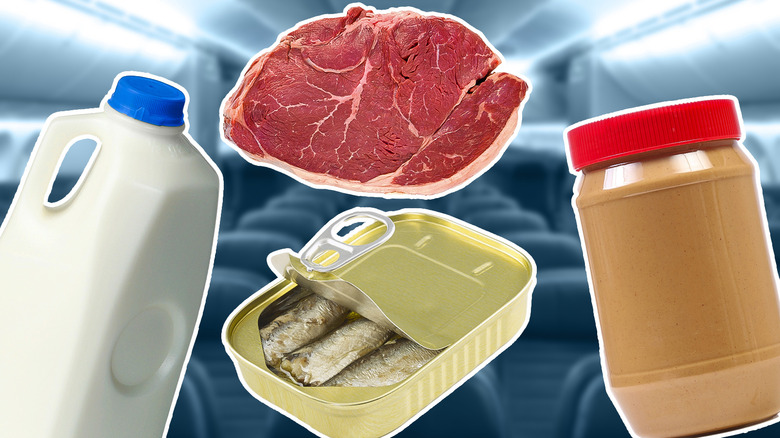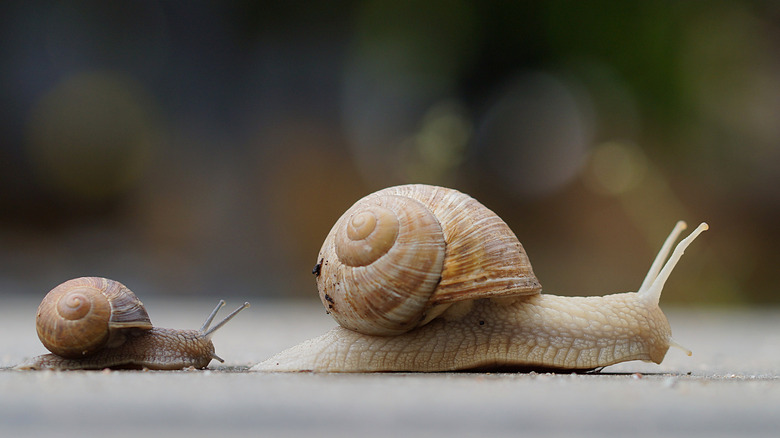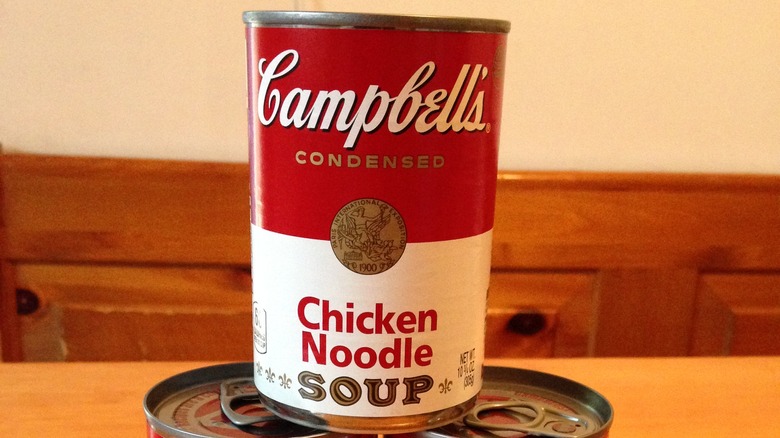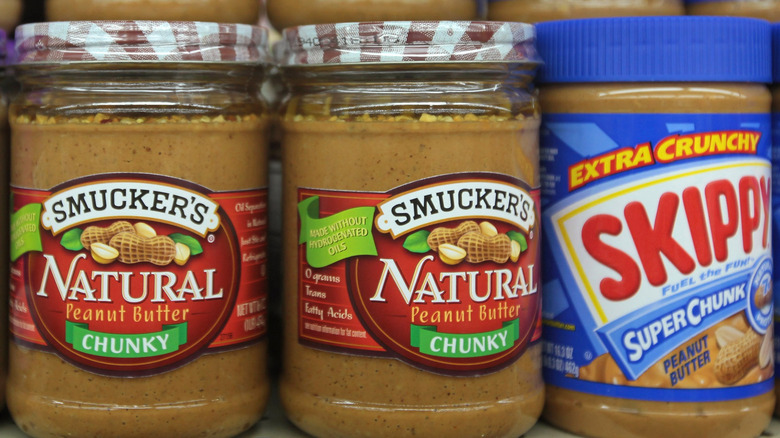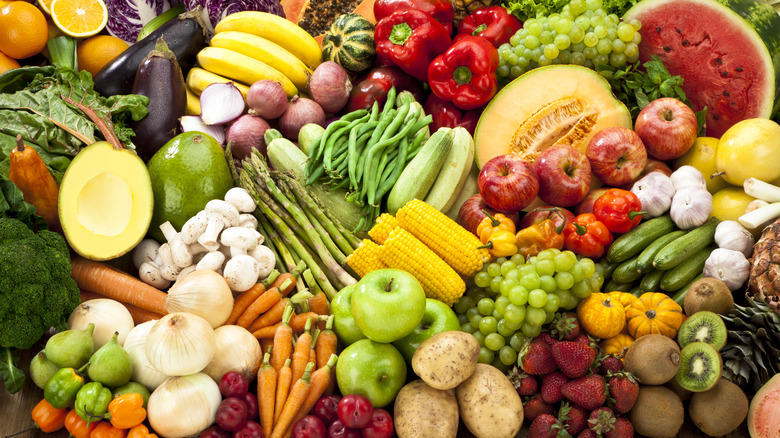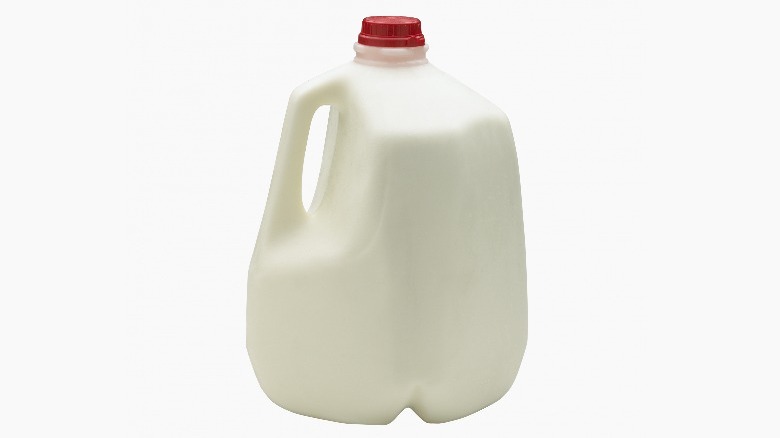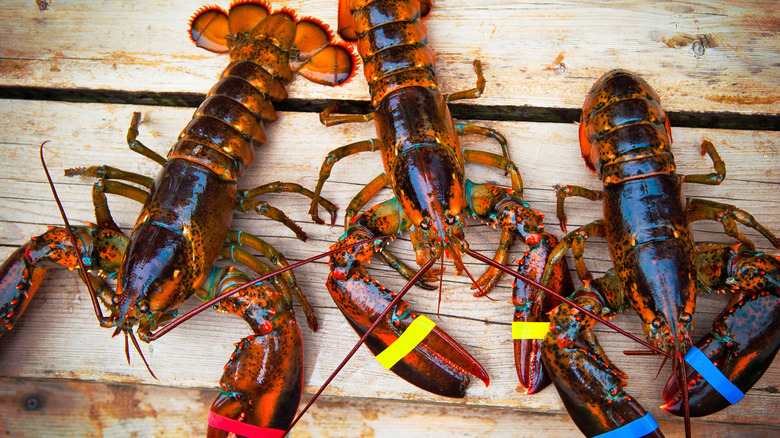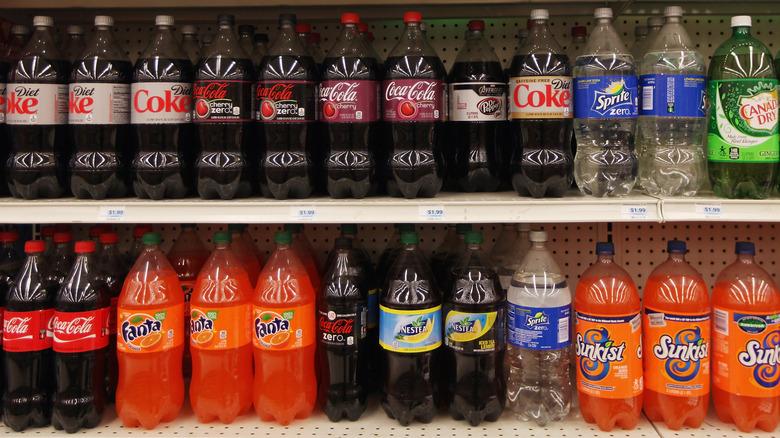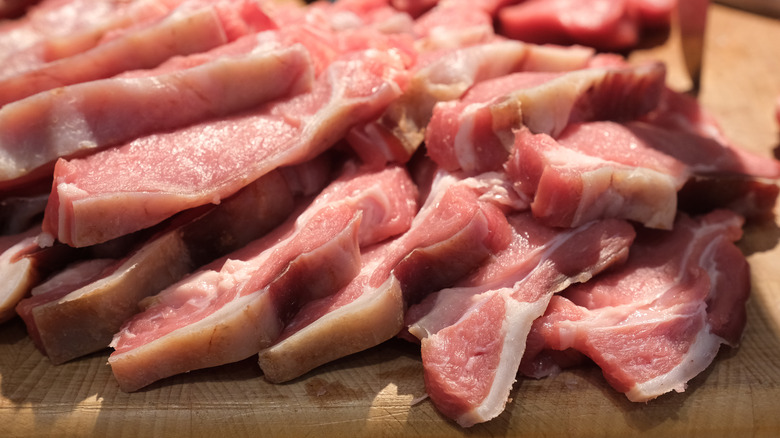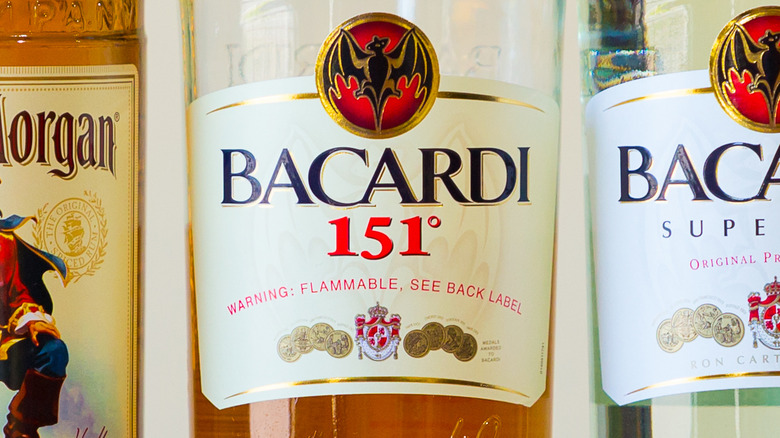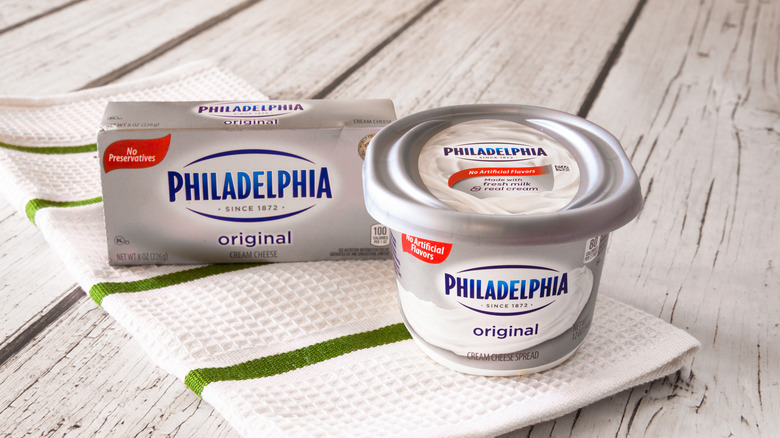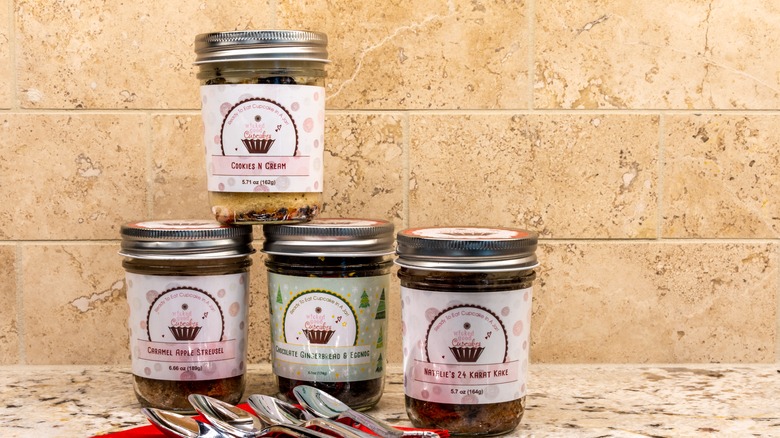Foods You Absolutely Cannot Take With You On An Airplane
The state of air travel in a post-9/11 world can be tough to swallow at times. Sure, we understand many of the restrictions imposed on travelers in the wake of the heinous terrorist attacks more than two decades ago. Yet we can't help but furrow our brow over some of the long-running, long-standing regulations that remain in place. Case in point: The fairly absurd, seemingly illogical rules regarding food and beverages one can carry on an airplane.
Now, there are plenty of reasons why someone may want to bring a food or drink item onto an airplane (more specifically, in their carry-on bag). For starters, there's the historically less-than-stellar reputation of airplane meals, as well as the often-inflated food prices airlines (and airports) tend to charge. Other times, an individual traveling with a rare ingredient they want to prepare at their destination may prefer to keep it in their sights the entire trip.
Whatever the rationale, there are a number of food restrictions airborne U.S. travelers should consider before heading to the airport. If you're eager to avoid having your food items confiscated or finding yourself forced to unexpectedly check a bag, we've got you covered. Without further ado, here are the foods you absolutely cannot take on an airplane (in your carry-on bag, that is).
Escargots (into the US from a foreign location)
Invasive species can wreak genuine havoc on their new homes — look at how frogs devastated the Land Down Under when "The Simpsons" visited the continent in "Bart vs. Australia." Consequently, there's ample reason for a country to restrict the entry of certain animals. Naturally, the U.S. highly regulates the transportation of live animals into the nation via airplane. If you're considering flying back to the States with a terrarium full of snails to enjoy some homemade escargots, the USDA has some bad news for you: It's illegal to do so.
Based on recent occurrences where passengers were found to have flown into the U.S. with live snails, you may be more apt to have the animal confiscated by customs agents after you land rather than before. Two giant African snails were found (and taken from) the suitcase of a traveler who'd arrived in Atlanta, Georgia, from Nigeria in June 2019 (per The Atlanta Journal-Constitution), while a single giant African snail was discovered on a different passenger (also in Atlanta) in November 2022 (via ABC13 News).
If you're determined to bring this slug-like protein source back into the U.S., the USDA permits non-living snails to be shipped into the country. In other words, don't try bringing live snails back in your carry-on; instead, let FedEx fly your escargots back from an international location.
Canned foods
Oftentimes, there's at least some logic to be inferred from the Transportation Security Administration's (TSA) restrictions regarding items allowed on an airplane. Other times, we're sort of baffled by the way it chooses to categorize certain items, particularly when it comes to food. The fact that canned foods are usually considered a liquid (regardless of what's inside) leaves those products at the mercy of the 3-1-1 rule — meaning your canned vegetables might end up in the trash, not your destination.
For the inexperienced traveler, you may wonder about the 3-1-1 rule. Under this guideline, a traveler can only bring up to 3.4 ounces of any liquid in their carry-on bag (in a secure container); they must store all such liquids in a single (as in one) clear bag; and they are only allowed one such bag per trip (in their carry-on bag, that is).
Now, if you're wondering whether you can sneak a canned food item onto a plane if it contains, say, chili, or some other not-quite-liquid food inside, well ... the short answer is no. After all, for simplicity's sake, it appears the TSA lumps all canned items together as a liquid regardless of the contents. If you must fly from one place to another with several cans of cream of mushroom soup, skip the hassle and store it in a checked bag.
A jar of peanut butter
Certain truths are understood by everyone — for example, peanut butter is a liquid. Wait ... that's not right, is it? Well, if you're going by the TSA's guidelines, it appears the smooth and creamy blend of peanuts (the food that's become childhood lunchbox royalty between pieces of bread) is indeed a liquid. So if you're attempting to bring an extra-large jar of Skippy on your next flight (or even a standard-sized jar), you'll still make your flight — but the peanut butter won't.
Now, to be fair, the specific categorization of peanut butter can be difficult to pin down between solid and liquid. But it still seems odd that the food item — one that's essentially never consumed as a beverage — would be listed as a liquid for any purpose whatsoever. Then again, the precise reason for labeling peanut butter as a liquid when flying may not be that difficult to decipher.
After all, peanut butter is likely included in the maximum of 3.4 ounces of liquid as a way to simplify the process for TSA agents — which, in turn, speeds up the security checkpoint for travelers. With that in mind, don't fret about your inability to bring a jar of peanut butter in your carry-on. Rather, be glad you can make it to your terminal with time to spare.
Fresh produce
Invasive species aren't limited solely to animals, and plenty of plants have the capacity to overwhelm the native vegetation of a new spot too. But it's not just a matter of non-native fruits or vegetables potentially destroying the ecosystem of a new environment that explains why some fresh produce is prohibited on airplanes — it's the bugs and insects that may be hitching a ride, as well. Hence, depending on where you're traveling from (or to), you may not be able to bring fresh produce with you on an airplane.
To be clear, if you're flying domestically within the continental United States and hope to bring fresh fruit or veggies as a mid-flight snack, you should be in the clear. But if you're a U.S. citizen flying onto the mainland from Puerto Rico or Hawaii, there's a better-than-average chance you won't be able to bring the fresh produce you've got on hand.
Now, while some fresh produce from non-continental U.S. locations may be permitted on an airplane, it's exceptionally difficult to find a thorough or detailed list. After all, as Anthony L. Bucci, a U.S. Customs and Border Protection public affairs specialist, told The New York Times in 2016, "We're following 400 different laws on behalf of 40 other agencies." Consider double-checking the rules and regulations of your destination before heading to the airport.
A gallon of milk
It's a little-known fact that the TSA has an extremely strict, unbending rule regarding how much liquid a person can bring aboard an airplane in their carry-on bag ... just kidding! We'd actually argue no fact regarding airline travel is more widely known (and decried) than the 3.4 ounces or less rule for liquids. In other words, anyone concerned their vacation spot won't have the right kind of milk shouldn't expect to be allowed to take a gallon on board with them (whether it's dairy or plant-based).
We suppose if you're absolutely committed to flying with a gallon (or quart, or any other sized container) of milk with you, you can store it in a checked bag (do you notice the pattern, here?). Of course, if your milk of choice is dairy-based, storing it in a checked bag may make you sick upon arrival. But if you prefer a shelf-stable variety of milk, it may make the trip unscathed.
Thankfully for parents of young children, there is one exception to the 3.4 ounces or less regulation when it comes to milk on an airplane: breast milk. In fact, the TSA categorizes breast milk as a medically necessary liquid, meaning parents worried about a hungry or finicky child can rest easy (just be sure to alert a TSA agent before your bag is scanned).
Live lobster (depending on the airline)
There's nothing in the world like lobster. Of course, while American lobster can be found along much of the Atlantic coast, it's most identified with New England. So while it's obvious why someone flying home after a weekend in New England would want to cook the bottom-dwelling sea insect, if you're hoping to transport a live lobster on an airplane, you'll want to check with the airline first — or the lobster might not make it on board.
Now, if you're curious why someone would want to fly with a live lobster (as opposed to a dead one), the realities of shellfish-as-food make it impractical (and dangerous) to kill a lobster before preparing it. In fact, since live lobster flesh contains highly-toxic bacteria that grow exponentially the moment a lobster is killed (per BBC Science Focus), the risk of food poisoning when preparing and eating an already-dead lobster is incredibly high.
Considering lobster meat begins to spoil the instant the animal is no longer alive, it's understandable that someone would need to fly with a live lobster in order to eventually enjoy it. Just heed the TSA's advice if you choose to do so, and make sure ahead of time that the animal is permitted by your airline.
A two-liter soda bottle
More often than not, there are enough restaurants and shops inside an airport to help a parched person quench their thirst. Of course, once you pass through security, you're also at the mercy of those businesses — meaning you're prone to pay a pretty penny for just about every beverage. Unfortunately, if you're hoping to skirt the excessive upcharge of a Coke or Mountain Dew at an airport CVS, don't try bringing a two-liter of soda to the airport — because it won't make it past TSA.
When you consider no popular soda brand seems to sell a product below 3.4 ounces — even mini cans are still 7.5 ounces each – there's no feasible way to bring any amount of soda (two-liter or otherwise) through airport security. Obviously, you can bring a bottle or can of soda you buy after passing through security onto an airplane, but if you purchase it outside the airport it won't make it on the airplane.
Improperly packaged raw meat
We've all been there: You're in a rush to make a flight, so you haphazardly pack your bag, leaving your items less than organized. However, if you're flying with certain foods or drinks, you won't want to be so blasé about improper packing. If you're inclined to bring raw meat on an airplane, for example, you'll need to make sure you pack it precisely and ensure it fits the USDA requirements.
Setting aside what might possess a person to fill their carry-on bag with poorly packaged (or even loose) pork chops — or any other type of raw meat, for that matter — it's really quite clear why bringing food in such a state on an airplane is restricted. Frankly, the safety concerns of raw meat alone (hello, food poisoning) are enough to justify a TSA agent deciding to confiscate (and destroy) your animal protein in such a circumstance.
Provided you do, in fact, pack your package of raw meat as suggested — in a properly-sealed cooler with fully frozen ice packs — it should be smooth sailing (or flying, rather). But if you're unconcerned with the necessary rules for bringing raw meat on an airplane, don't expect to fly with the protein in question.
Partially-melted frozen foods
When it comes to foods you absolutely cannot take on an airplane, we found far fewer fully-banned items than initially anticipated. Not to say there's a free-for-all in regards to what you're allowed to take in your carry-on. After all, even food that's permitted may be confiscated at security if a person ignores the provided specifications. In that vein, if you're looking to fly with frozen food in your carry-on, make sure it's fully frozen with no melted liquid present. Otherwise? It won't make the trip.
To be clear, you can take frozen food on an airplane, but it has to be completely frozen. Since a frozen item won't remain in that state for long if it's freely exposed to the elements, a cooler is likely your best bet. Of course, if the frozen ice packs inside your cooler start to melt, you'll run into trouble. If any amount of liquid is detected, you almost certainly won't be able to bring it on the plane (as a carry-on, at least).
Perhaps you're pleasantly surprised to discover frozen foods aren't entirely banned on airplanes. But considering the strict requirements (and the risk that a partially-melted item won't make it on board), you may be best served simply keeping frozen items in your freezer at home.
Alcohol (if it's 140 proof or higher)
We'd have to believe that, at this point, you've noticed a not-so-subtle trend — namely, that many foods you can't take with you in your carry-on bags can be secured (and then flown) in a checked bag instead. Yet one specific type of beverage is completely banned from being taken on an airplane in the U.S., even in a checked piece of luggage: alcohol above 140 proof.
In fact, such high-proof alcohols (those with a 70% alcohol by volume content or higher) appear to be one of the only consumable food items you absolutely cannot take on an airplane. Now, we can't verify (with any real certainty) the rationale behind this relatively peculiar distinction. After all, alcoholic beverages below 140 proof can still be brought aboard airplanes; you can even bring mini booze bottles in your carry-on (provided it doesn't exceed the 3.4-ounce threshold).
More than likely (or, at least, our assumption), the rule is based on the inherently greater flammability and resulting fire hazard posed by higher-proof alcohols. Whatever the reason, purchase your bottle of Bacardi 151 following your flight and stick with a lower-proof rum at the duty-free shop.
A tub of cream cheese or other soft cheeses
Rules around what you can and cannot bring on a plane are full of nuances. While solid hard cheese is allowed on planes without an issue, soft cheese is not. For example, cream cheese is considered a spread or dip and must adhere to the 3.4-ounce limit. Sadly, the standard size for tubs of cream cheese is 8 ounces, more than double what is allowed.
The TSA made a special note of this rule on its Twitter account, stating that bagels are allowed on planes, but unless the cream cheese is already spread, you can't bring it in a standard tub. Previously, there was a case where a family attempted to take bagels, lox, and cream cheese on a plane, but unfortunately, the cream cheese was not allowed on the flight. One way around this is to spread the cream cheese on the bagel before passing through security, as this will generally make it exempt from the ruling.
Cream cheese is not the only cheese that must follow this rule. Other soft cheeses such as mascarpone and brie must also be packed in a format of 3.4 ounces or less, or they will not be allowed on your flight.
Jarred cupcakes
As we have learned thus far, oftentimes, the rules about what you can bring on a plane are not so much about the food themselves but more about the way they are packaged. If you are traveling by plane and bringing cupcakes, you will want to pack them in a way that they arrive in one piece. One of the safest ways to ensure this is to bake the cupcakes in individual mason jars. As it turns out, this kind of packaging will not make it through TSA.
Cake and cupcakes themselves are permitted through TSA, but a 2011 case set a precedent that determined when the treats are packed in a jar, they somehow transform from being a food item to a liquid. The rationale, as reported by ABC News, is that since the frosting and fillings take the shape of a container, they are considered liquid, which is the same reason that prohibits you from bringing jars of peanut butter. However, if they are not encased in a jar and hold their shape, they are solid. Confused? So were many other people. However, the TSA defended its decision in a since-deleted blog post called "Cupcakegate." So, if you plan on flying with sweet treats in the future, opt for a traditional cupcake over a jarred one.
